Business Law: Different Business Organizations and Consequences
VerifiedAdded on 2022/12/14
|11
|2792
|72
Report
AI Summary
This report delves into the realm of business law, analyzing various types of business organizations and their respective legal consequences. It begins by introducing the concept of business and the role of business law in regulating commercial activities. The main body of the report explores different organizational structures, including sole proprietorships, partnerships, private limited companies, and public limited companies, highlighting their key characteristics, benefits, and disadvantages. The report then examines the legal consequences associated with each type of organization, such as liability for debts, regulatory requirements, and implications for business owners. The report also provides recommendations for a sole trader looking to expand their business, suggesting the advantages of forming a partnership. Finally, the conclusion summarizes the key findings, emphasizing the importance of understanding business law and choosing the appropriate organizational structure to ensure legal compliance and business success.
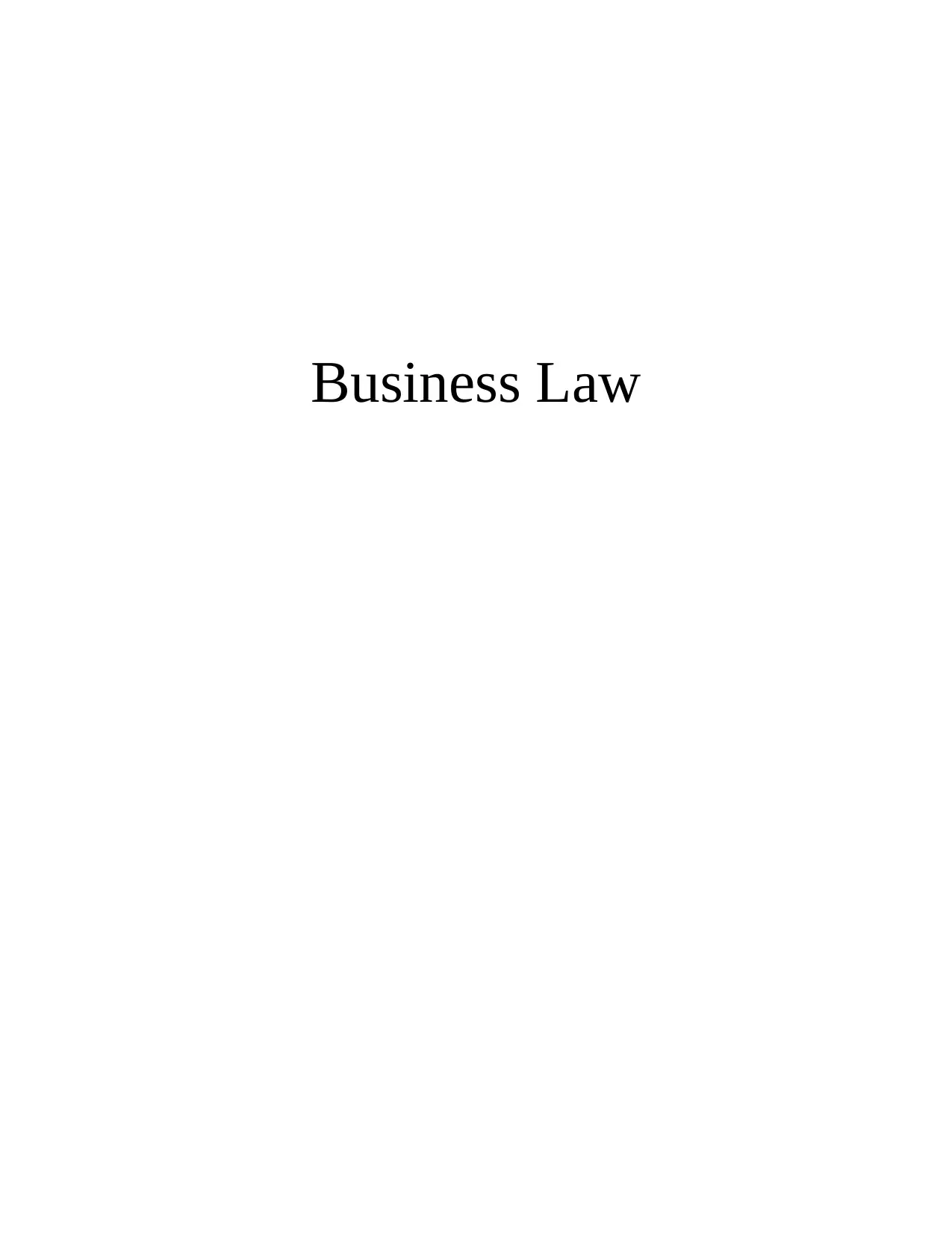
Business Law
Paraphrase This Document
Need a fresh take? Get an instant paraphrase of this document with our AI Paraphraser
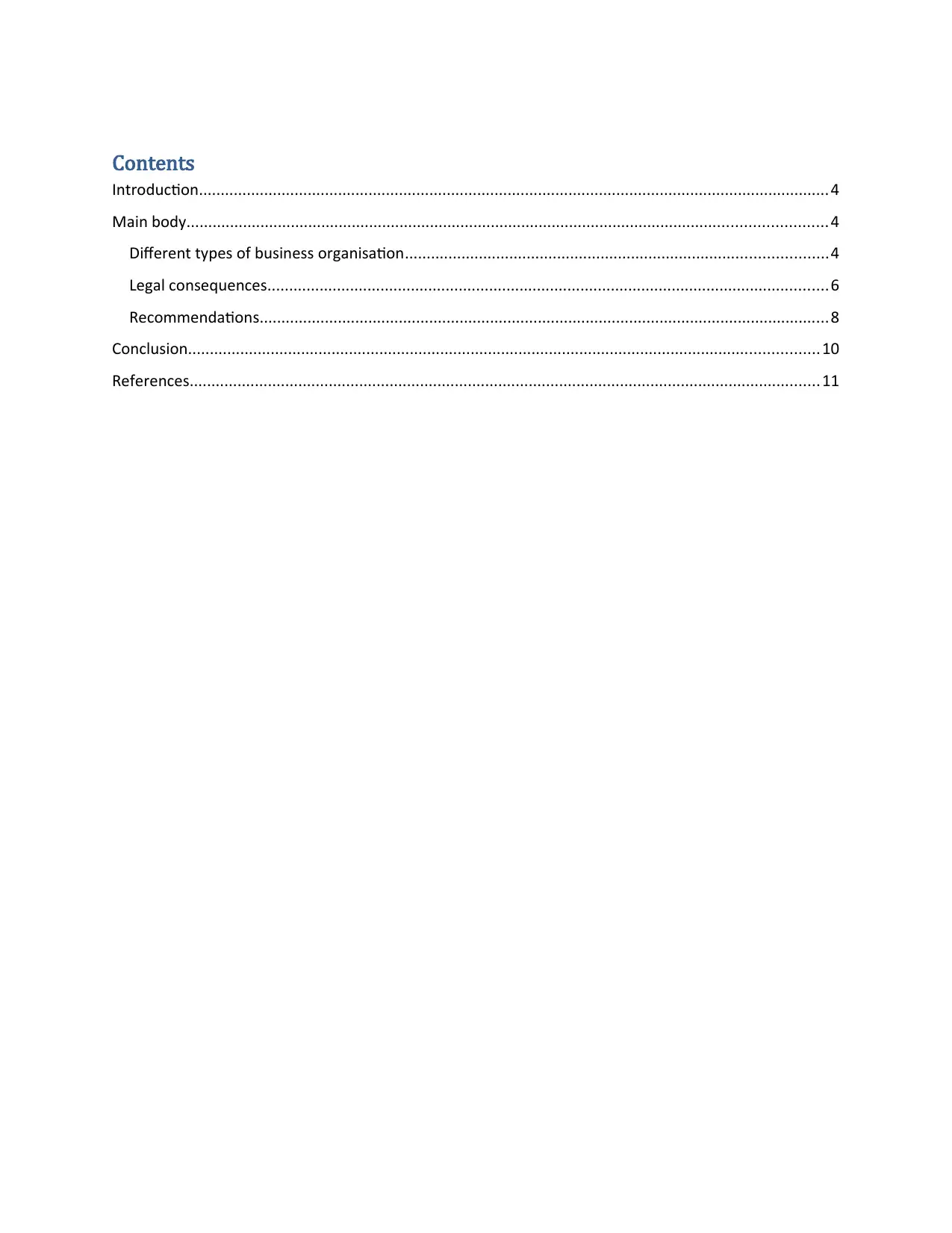
Contents
Introduction.................................................................................................................................................4
Main body...................................................................................................................................................4
Different types of business organisation.................................................................................................4
Legal consequences.................................................................................................................................6
Recommendations...................................................................................................................................8
Conclusion.................................................................................................................................................10
References.................................................................................................................................................11
Introduction.................................................................................................................................................4
Main body...................................................................................................................................................4
Different types of business organisation.................................................................................................4
Legal consequences.................................................................................................................................6
Recommendations...................................................................................................................................8
Conclusion.................................................................................................................................................10
References.................................................................................................................................................11
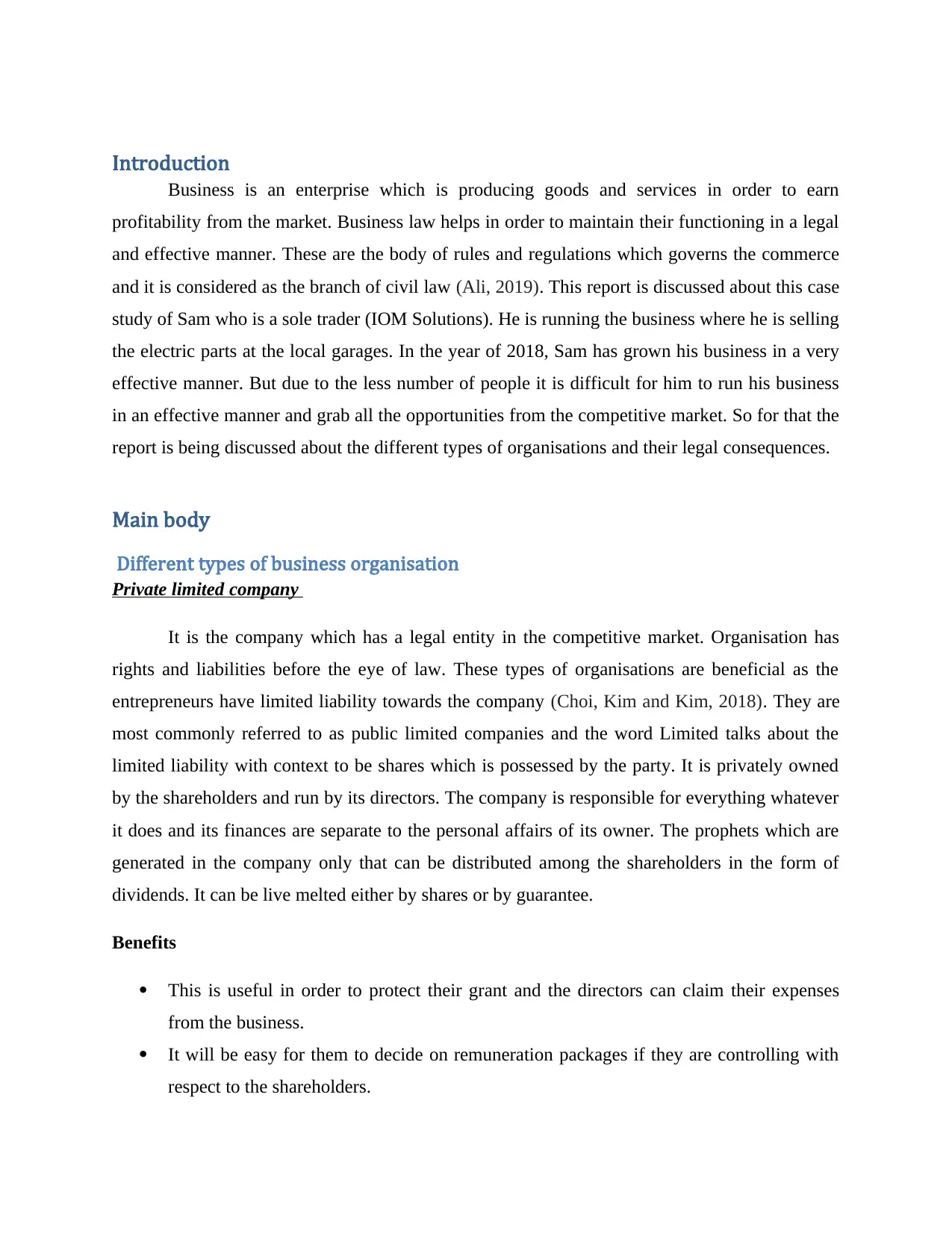
Introduction
Business is an enterprise which is producing goods and services in order to earn
profitability from the market. Business law helps in order to maintain their functioning in a legal
and effective manner. These are the body of rules and regulations which governs the commerce
and it is considered as the branch of civil law (Ali, 2019). This report is discussed about this case
study of Sam who is a sole trader (IOM Solutions). He is running the business where he is selling
the electric parts at the local garages. In the year of 2018, Sam has grown his business in a very
effective manner. But due to the less number of people it is difficult for him to run his business
in an effective manner and grab all the opportunities from the competitive market. So for that the
report is being discussed about the different types of organisations and their legal consequences.
Main body
Different types of business organisation
Private limited company
It is the company which has a legal entity in the competitive market. Organisation has
rights and liabilities before the eye of law. These types of organisations are beneficial as the
entrepreneurs have limited liability towards the company (Choi, Kim and Kim, 2018). They are
most commonly referred to as public limited companies and the word Limited talks about the
limited liability with context to be shares which is possessed by the party. It is privately owned
by the shareholders and run by its directors. The company is responsible for everything whatever
it does and its finances are separate to the personal affairs of its owner. The prophets which are
generated in the company only that can be distributed among the shareholders in the form of
dividends. It can be live melted either by shares or by guarantee.
Benefits
This is useful in order to protect their grant and the directors can claim their expenses
from the business.
It will be easy for them to decide on remuneration packages if they are controlling with
respect to the shareholders.
Business is an enterprise which is producing goods and services in order to earn
profitability from the market. Business law helps in order to maintain their functioning in a legal
and effective manner. These are the body of rules and regulations which governs the commerce
and it is considered as the branch of civil law (Ali, 2019). This report is discussed about this case
study of Sam who is a sole trader (IOM Solutions). He is running the business where he is selling
the electric parts at the local garages. In the year of 2018, Sam has grown his business in a very
effective manner. But due to the less number of people it is difficult for him to run his business
in an effective manner and grab all the opportunities from the competitive market. So for that the
report is being discussed about the different types of organisations and their legal consequences.
Main body
Different types of business organisation
Private limited company
It is the company which has a legal entity in the competitive market. Organisation has
rights and liabilities before the eye of law. These types of organisations are beneficial as the
entrepreneurs have limited liability towards the company (Choi, Kim and Kim, 2018). They are
most commonly referred to as public limited companies and the word Limited talks about the
limited liability with context to be shares which is possessed by the party. It is privately owned
by the shareholders and run by its directors. The company is responsible for everything whatever
it does and its finances are separate to the personal affairs of its owner. The prophets which are
generated in the company only that can be distributed among the shareholders in the form of
dividends. It can be live melted either by shares or by guarantee.
Benefits
This is useful in order to protect their grant and the directors can claim their expenses
from the business.
It will be easy for them to decide on remuneration packages if they are controlling with
respect to the shareholders.
⊘ This is a preview!⊘
Do you want full access?
Subscribe today to unlock all pages.

Trusted by 1+ million students worldwide
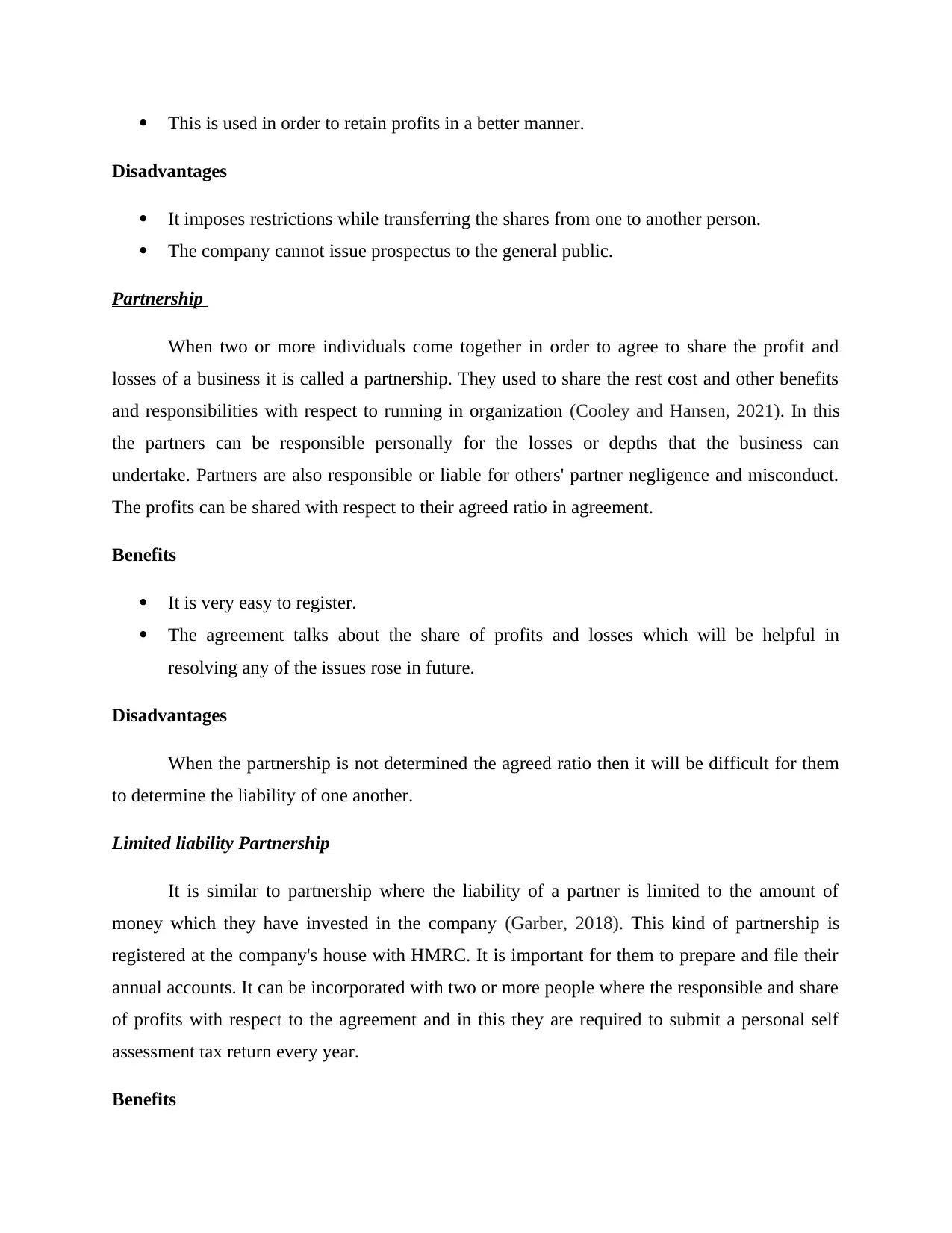
This is used in order to retain profits in a better manner.
Disadvantages
It imposes restrictions while transferring the shares from one to another person.
The company cannot issue prospectus to the general public.
Partnership
When two or more individuals come together in order to agree to share the profit and
losses of a business it is called a partnership. They used to share the rest cost and other benefits
and responsibilities with respect to running in organization (Cooley and Hansen, 2021). In this
the partners can be responsible personally for the losses or depths that the business can
undertake. Partners are also responsible or liable for others' partner negligence and misconduct.
The profits can be shared with respect to their agreed ratio in agreement.
Benefits
It is very easy to register.
The agreement talks about the share of profits and losses which will be helpful in
resolving any of the issues rose in future.
Disadvantages
When the partnership is not determined the agreed ratio then it will be difficult for them
to determine the liability of one another.
Limited liability Partnership
It is similar to partnership where the liability of a partner is limited to the amount of
money which they have invested in the company (Garber, 2018). This kind of partnership is
registered at the company's house with HMRC. It is important for them to prepare and file their
annual accounts. It can be incorporated with two or more people where the responsible and share
of profits with respect to the agreement and in this they are required to submit a personal self
assessment tax return every year.
Benefits
Disadvantages
It imposes restrictions while transferring the shares from one to another person.
The company cannot issue prospectus to the general public.
Partnership
When two or more individuals come together in order to agree to share the profit and
losses of a business it is called a partnership. They used to share the rest cost and other benefits
and responsibilities with respect to running in organization (Cooley and Hansen, 2021). In this
the partners can be responsible personally for the losses or depths that the business can
undertake. Partners are also responsible or liable for others' partner negligence and misconduct.
The profits can be shared with respect to their agreed ratio in agreement.
Benefits
It is very easy to register.
The agreement talks about the share of profits and losses which will be helpful in
resolving any of the issues rose in future.
Disadvantages
When the partnership is not determined the agreed ratio then it will be difficult for them
to determine the liability of one another.
Limited liability Partnership
It is similar to partnership where the liability of a partner is limited to the amount of
money which they have invested in the company (Garber, 2018). This kind of partnership is
registered at the company's house with HMRC. It is important for them to prepare and file their
annual accounts. It can be incorporated with two or more people where the responsible and share
of profits with respect to the agreement and in this they are required to submit a personal self
assessment tax return every year.
Benefits
Paraphrase This Document
Need a fresh take? Get an instant paraphrase of this document with our AI Paraphraser
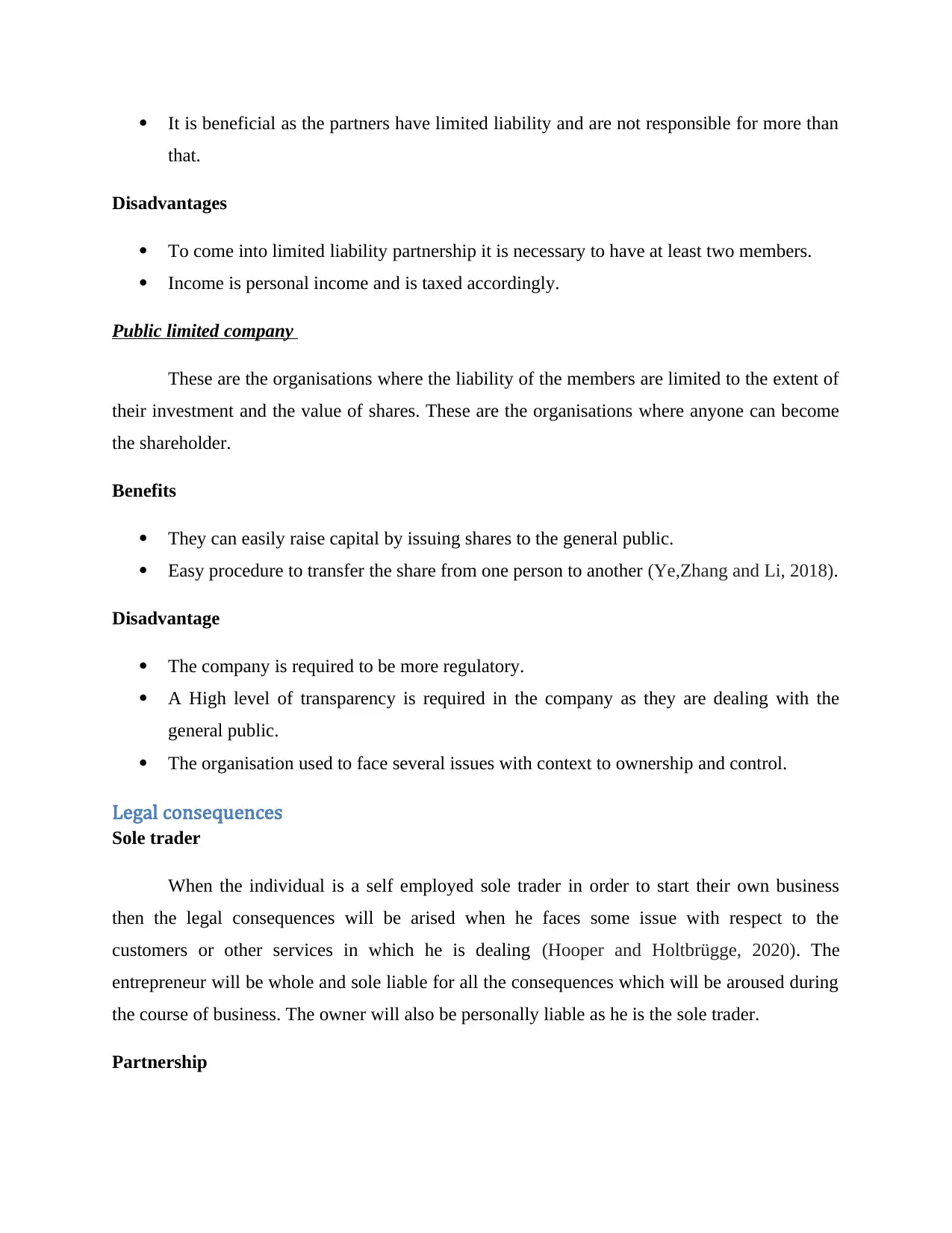
It is beneficial as the partners have limited liability and are not responsible for more than
that.
Disadvantages
To come into limited liability partnership it is necessary to have at least two members.
Income is personal income and is taxed accordingly.
Public limited company
These are the organisations where the liability of the members are limited to the extent of
their investment and the value of shares. These are the organisations where anyone can become
the shareholder.
Benefits
They can easily raise capital by issuing shares to the general public.
Easy procedure to transfer the share from one person to another (Ye,Zhang and Li, 2018).
Disadvantage
The company is required to be more regulatory.
A High level of transparency is required in the company as they are dealing with the
general public.
The organisation used to face several issues with context to ownership and control.
Legal consequences
Sole trader
When the individual is a self employed sole trader in order to start their own business
then the legal consequences will be arised when he faces some issue with respect to the
customers or other services in which he is dealing (Hooper and Holtbrügge, 2020). The
entrepreneur will be whole and sole liable for all the consequences which will be aroused during
the course of business. The owner will also be personally liable as he is the sole trader.
Partnership
that.
Disadvantages
To come into limited liability partnership it is necessary to have at least two members.
Income is personal income and is taxed accordingly.
Public limited company
These are the organisations where the liability of the members are limited to the extent of
their investment and the value of shares. These are the organisations where anyone can become
the shareholder.
Benefits
They can easily raise capital by issuing shares to the general public.
Easy procedure to transfer the share from one person to another (Ye,Zhang and Li, 2018).
Disadvantage
The company is required to be more regulatory.
A High level of transparency is required in the company as they are dealing with the
general public.
The organisation used to face several issues with context to ownership and control.
Legal consequences
Sole trader
When the individual is a self employed sole trader in order to start their own business
then the legal consequences will be arised when he faces some issue with respect to the
customers or other services in which he is dealing (Hooper and Holtbrügge, 2020). The
entrepreneur will be whole and sole liable for all the consequences which will be aroused during
the course of business. The owner will also be personally liable as he is the sole trader.
Partnership
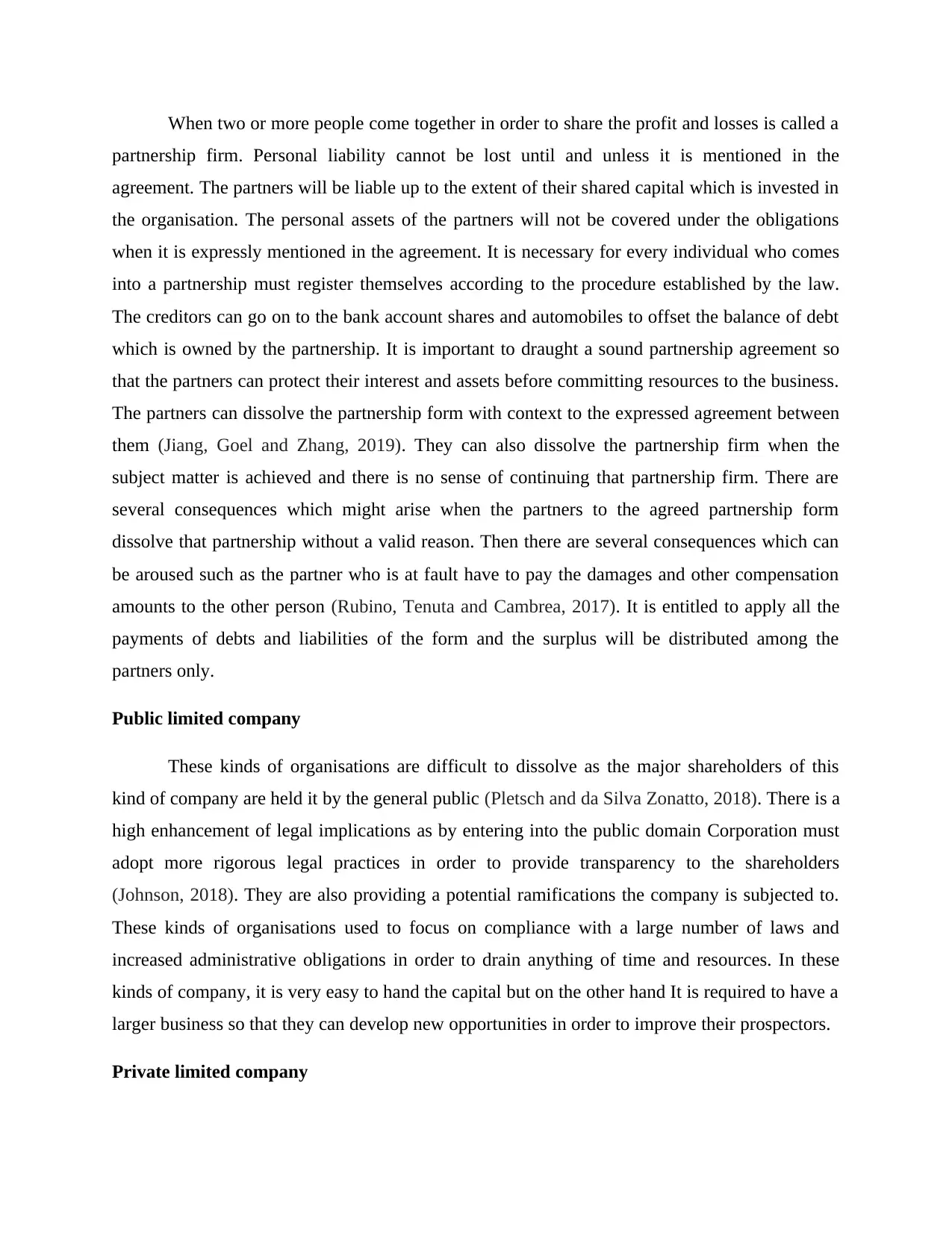
When two or more people come together in order to share the profit and losses is called a
partnership firm. Personal liability cannot be lost until and unless it is mentioned in the
agreement. The partners will be liable up to the extent of their shared capital which is invested in
the organisation. The personal assets of the partners will not be covered under the obligations
when it is expressly mentioned in the agreement. It is necessary for every individual who comes
into a partnership must register themselves according to the procedure established by the law.
The creditors can go on to the bank account shares and automobiles to offset the balance of debt
which is owned by the partnership. It is important to draught a sound partnership agreement so
that the partners can protect their interest and assets before committing resources to the business.
The partners can dissolve the partnership form with context to the expressed agreement between
them (Jiang, Goel and Zhang, 2019). They can also dissolve the partnership firm when the
subject matter is achieved and there is no sense of continuing that partnership firm. There are
several consequences which might arise when the partners to the agreed partnership form
dissolve that partnership without a valid reason. Then there are several consequences which can
be aroused such as the partner who is at fault have to pay the damages and other compensation
amounts to the other person (Rubino, Tenuta and Cambrea, 2017). It is entitled to apply all the
payments of debts and liabilities of the form and the surplus will be distributed among the
partners only.
Public limited company
These kinds of organisations are difficult to dissolve as the major shareholders of this
kind of company are held it by the general public (Pletsch and da Silva Zonatto, 2018). There is a
high enhancement of legal implications as by entering into the public domain Corporation must
adopt more rigorous legal practices in order to provide transparency to the shareholders
(Johnson, 2018). They are also providing a potential ramifications the company is subjected to.
These kinds of organisations used to focus on compliance with a large number of laws and
increased administrative obligations in order to drain anything of time and resources. In these
kinds of company, it is very easy to hand the capital but on the other hand It is required to have a
larger business so that they can develop new opportunities in order to improve their prospectors.
Private limited company
partnership firm. Personal liability cannot be lost until and unless it is mentioned in the
agreement. The partners will be liable up to the extent of their shared capital which is invested in
the organisation. The personal assets of the partners will not be covered under the obligations
when it is expressly mentioned in the agreement. It is necessary for every individual who comes
into a partnership must register themselves according to the procedure established by the law.
The creditors can go on to the bank account shares and automobiles to offset the balance of debt
which is owned by the partnership. It is important to draught a sound partnership agreement so
that the partners can protect their interest and assets before committing resources to the business.
The partners can dissolve the partnership form with context to the expressed agreement between
them (Jiang, Goel and Zhang, 2019). They can also dissolve the partnership firm when the
subject matter is achieved and there is no sense of continuing that partnership firm. There are
several consequences which might arise when the partners to the agreed partnership form
dissolve that partnership without a valid reason. Then there are several consequences which can
be aroused such as the partner who is at fault have to pay the damages and other compensation
amounts to the other person (Rubino, Tenuta and Cambrea, 2017). It is entitled to apply all the
payments of debts and liabilities of the form and the surplus will be distributed among the
partners only.
Public limited company
These kinds of organisations are difficult to dissolve as the major shareholders of this
kind of company are held it by the general public (Pletsch and da Silva Zonatto, 2018). There is a
high enhancement of legal implications as by entering into the public domain Corporation must
adopt more rigorous legal practices in order to provide transparency to the shareholders
(Johnson, 2018). They are also providing a potential ramifications the company is subjected to.
These kinds of organisations used to focus on compliance with a large number of laws and
increased administrative obligations in order to drain anything of time and resources. In these
kinds of company, it is very easy to hand the capital but on the other hand It is required to have a
larger business so that they can develop new opportunities in order to improve their prospectors.
Private limited company
⊘ This is a preview!⊘
Do you want full access?
Subscribe today to unlock all pages.

Trusted by 1+ million students worldwide
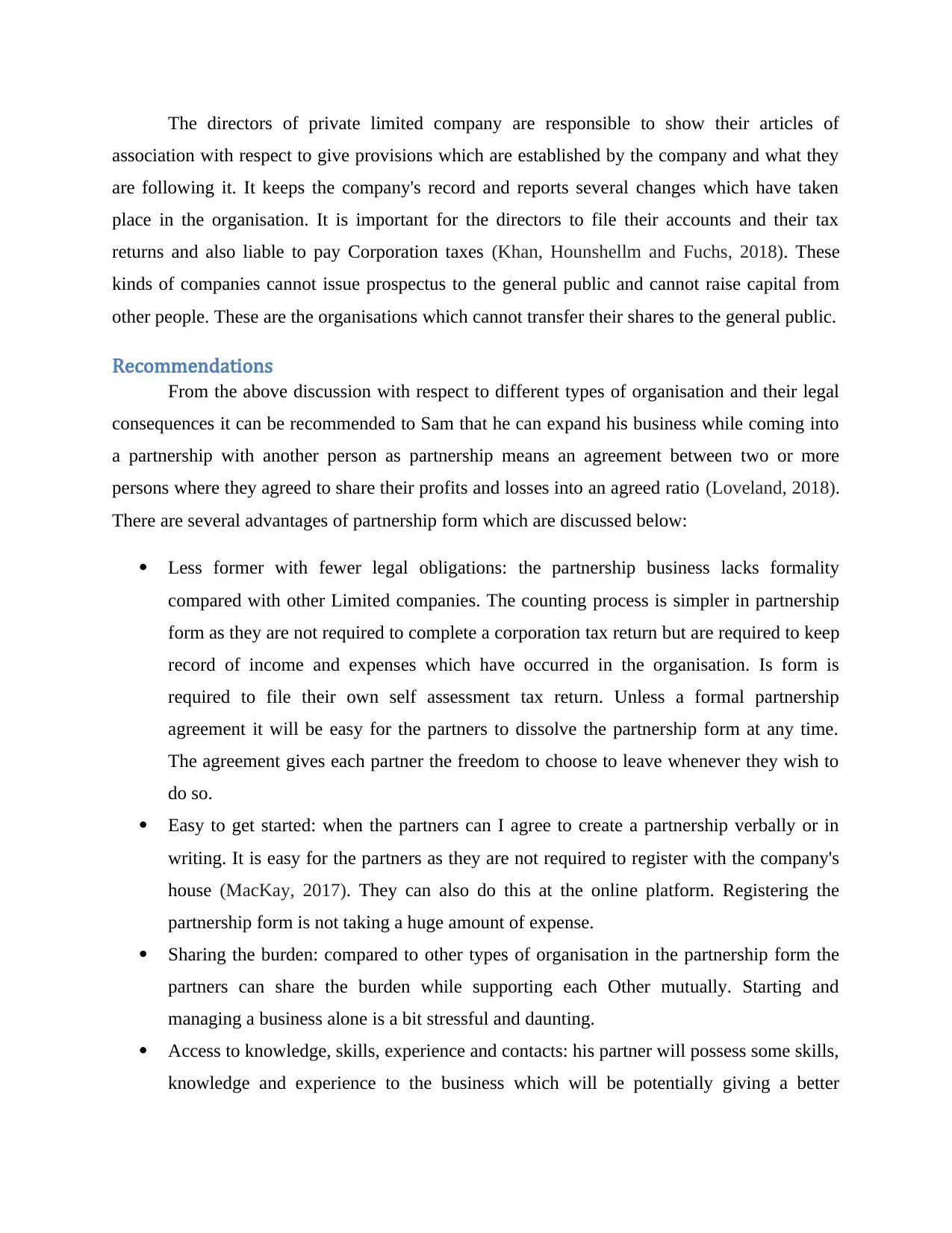
The directors of private limited company are responsible to show their articles of
association with respect to give provisions which are established by the company and what they
are following it. It keeps the company's record and reports several changes which have taken
place in the organisation. It is important for the directors to file their accounts and their tax
returns and also liable to pay Corporation taxes (Khan, Hounshellm and Fuchs, 2018). These
kinds of companies cannot issue prospectus to the general public and cannot raise capital from
other people. These are the organisations which cannot transfer their shares to the general public.
Recommendations
From the above discussion with respect to different types of organisation and their legal
consequences it can be recommended to Sam that he can expand his business while coming into
a partnership with another person as partnership means an agreement between two or more
persons where they agreed to share their profits and losses into an agreed ratio (Loveland, 2018).
There are several advantages of partnership form which are discussed below:
Less former with fewer legal obligations: the partnership business lacks formality
compared with other Limited companies. The counting process is simpler in partnership
form as they are not required to complete a corporation tax return but are required to keep
record of income and expenses which have occurred in the organisation. Is form is
required to file their own self assessment tax return. Unless a formal partnership
agreement it will be easy for the partners to dissolve the partnership form at any time.
The agreement gives each partner the freedom to choose to leave whenever they wish to
do so.
Easy to get started: when the partners can I agree to create a partnership verbally or in
writing. It is easy for the partners as they are not required to register with the company's
house (MacKay, 2017). They can also do this at the online platform. Registering the
partnership form is not taking a huge amount of expense.
Sharing the burden: compared to other types of organisation in the partnership form the
partners can share the burden while supporting each Other mutually. Starting and
managing a business alone is a bit stressful and daunting.
Access to knowledge, skills, experience and contacts: his partner will possess some skills,
knowledge and experience to the business which will be potentially giving a better
association with respect to give provisions which are established by the company and what they
are following it. It keeps the company's record and reports several changes which have taken
place in the organisation. It is important for the directors to file their accounts and their tax
returns and also liable to pay Corporation taxes (Khan, Hounshellm and Fuchs, 2018). These
kinds of companies cannot issue prospectus to the general public and cannot raise capital from
other people. These are the organisations which cannot transfer their shares to the general public.
Recommendations
From the above discussion with respect to different types of organisation and their legal
consequences it can be recommended to Sam that he can expand his business while coming into
a partnership with another person as partnership means an agreement between two or more
persons where they agreed to share their profits and losses into an agreed ratio (Loveland, 2018).
There are several advantages of partnership form which are discussed below:
Less former with fewer legal obligations: the partnership business lacks formality
compared with other Limited companies. The counting process is simpler in partnership
form as they are not required to complete a corporation tax return but are required to keep
record of income and expenses which have occurred in the organisation. Is form is
required to file their own self assessment tax return. Unless a formal partnership
agreement it will be easy for the partners to dissolve the partnership form at any time.
The agreement gives each partner the freedom to choose to leave whenever they wish to
do so.
Easy to get started: when the partners can I agree to create a partnership verbally or in
writing. It is easy for the partners as they are not required to register with the company's
house (MacKay, 2017). They can also do this at the online platform. Registering the
partnership form is not taking a huge amount of expense.
Sharing the burden: compared to other types of organisation in the partnership form the
partners can share the burden while supporting each Other mutually. Starting and
managing a business alone is a bit stressful and daunting.
Access to knowledge, skills, experience and contacts: his partner will possess some skills,
knowledge and experience to the business which will be potentially giving a better
Paraphrase This Document
Need a fresh take? Get an instant paraphrase of this document with our AI Paraphraser
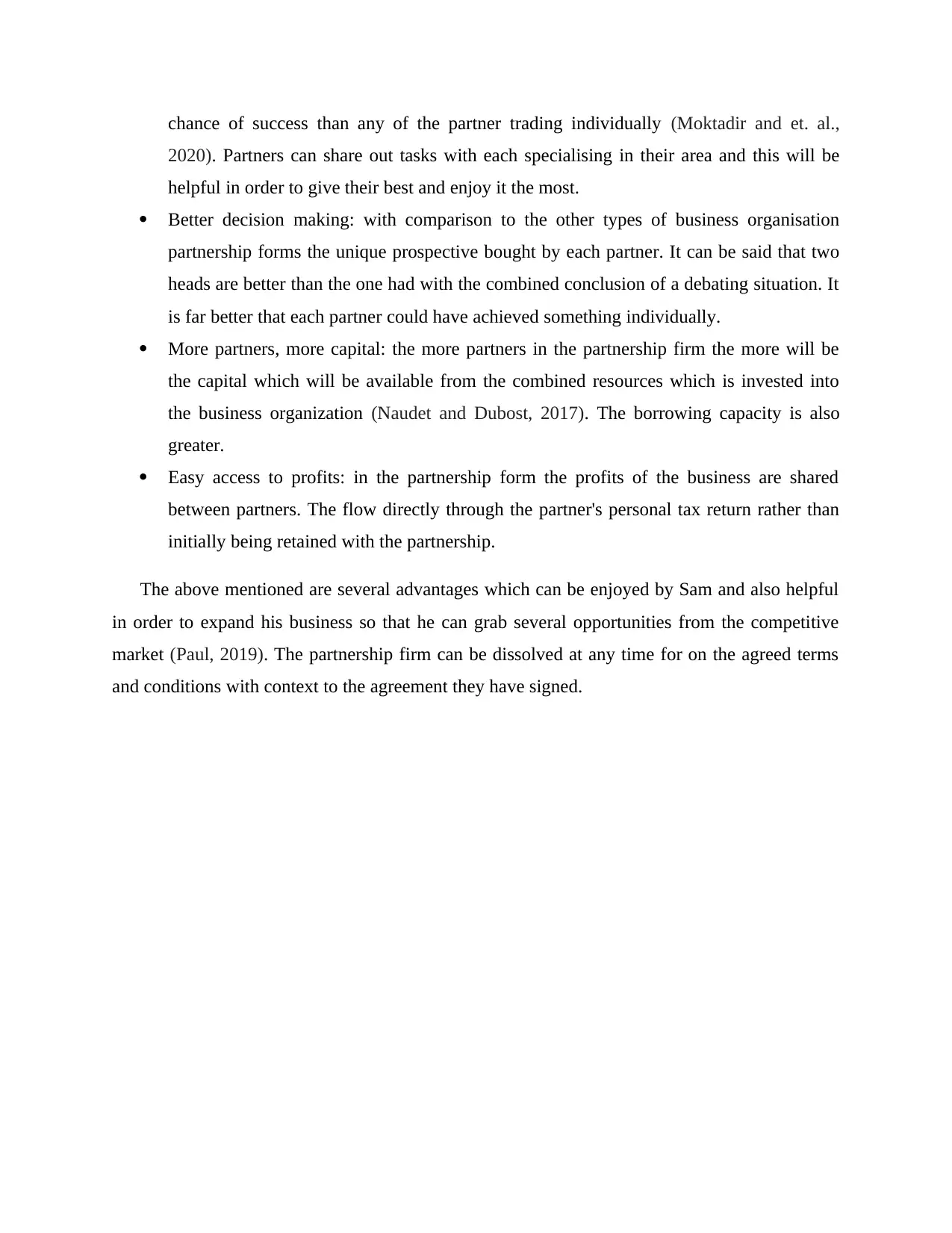
chance of success than any of the partner trading individually (Moktadir and et. al.,
2020). Partners can share out tasks with each specialising in their area and this will be
helpful in order to give their best and enjoy it the most.
Better decision making: with comparison to the other types of business organisation
partnership forms the unique prospective bought by each partner. It can be said that two
heads are better than the one had with the combined conclusion of a debating situation. It
is far better that each partner could have achieved something individually.
More partners, more capital: the more partners in the partnership firm the more will be
the capital which will be available from the combined resources which is invested into
the business organization (Naudet and Dubost, 2017). The borrowing capacity is also
greater.
Easy access to profits: in the partnership form the profits of the business are shared
between partners. The flow directly through the partner's personal tax return rather than
initially being retained with the partnership.
The above mentioned are several advantages which can be enjoyed by Sam and also helpful
in order to expand his business so that he can grab several opportunities from the competitive
market (Paul, 2019). The partnership firm can be dissolved at any time for on the agreed terms
and conditions with context to the agreement they have signed.
2020). Partners can share out tasks with each specialising in their area and this will be
helpful in order to give their best and enjoy it the most.
Better decision making: with comparison to the other types of business organisation
partnership forms the unique prospective bought by each partner. It can be said that two
heads are better than the one had with the combined conclusion of a debating situation. It
is far better that each partner could have achieved something individually.
More partners, more capital: the more partners in the partnership firm the more will be
the capital which will be available from the combined resources which is invested into
the business organization (Naudet and Dubost, 2017). The borrowing capacity is also
greater.
Easy access to profits: in the partnership form the profits of the business are shared
between partners. The flow directly through the partner's personal tax return rather than
initially being retained with the partnership.
The above mentioned are several advantages which can be enjoyed by Sam and also helpful
in order to expand his business so that he can grab several opportunities from the competitive
market (Paul, 2019). The partnership firm can be dissolved at any time for on the agreed terms
and conditions with context to the agreement they have signed.
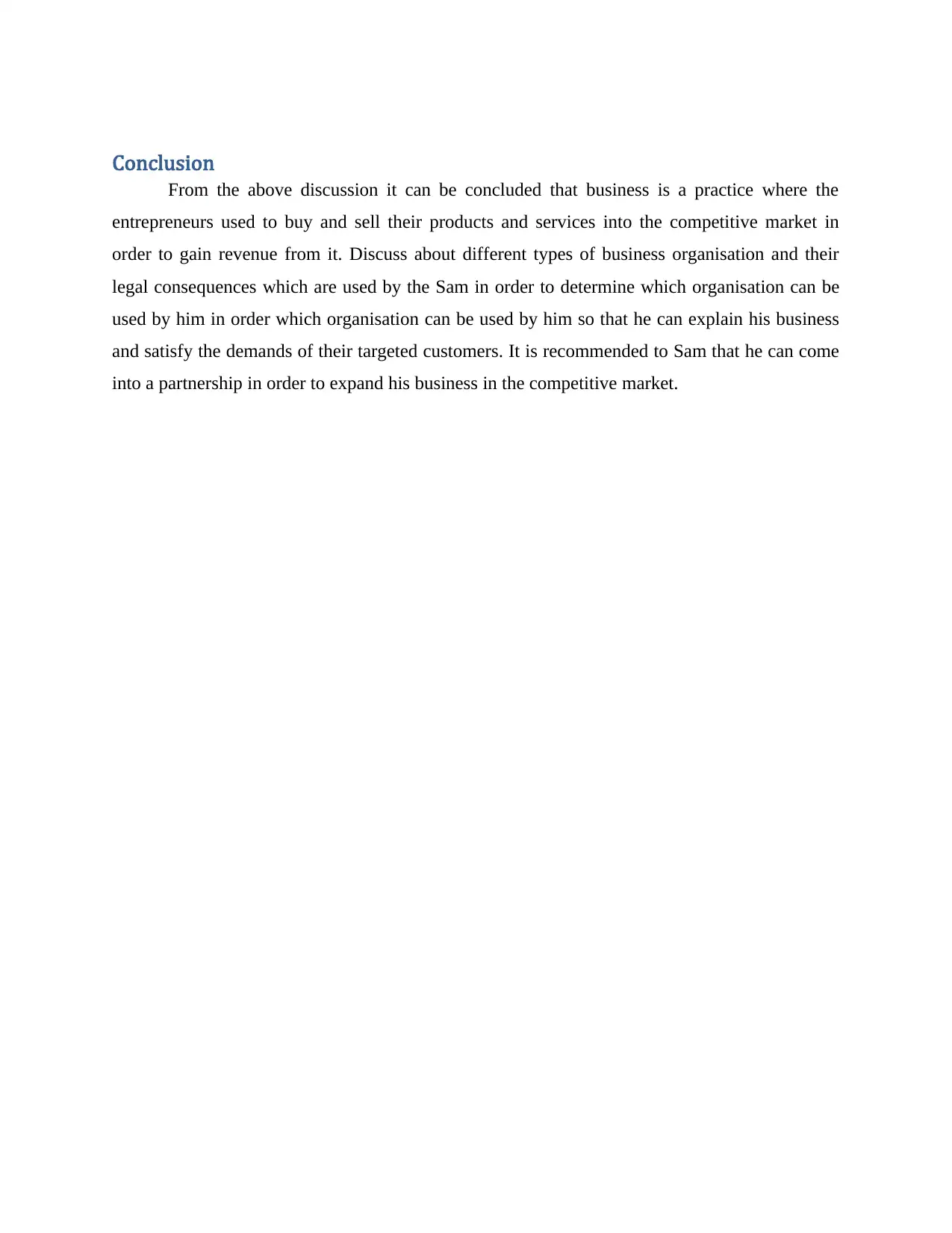
Conclusion
From the above discussion it can be concluded that business is a practice where the
entrepreneurs used to buy and sell their products and services into the competitive market in
order to gain revenue from it. Discuss about different types of business organisation and their
legal consequences which are used by the Sam in order to determine which organisation can be
used by him in order which organisation can be used by him so that he can explain his business
and satisfy the demands of their targeted customers. It is recommended to Sam that he can come
into a partnership in order to expand his business in the competitive market.
From the above discussion it can be concluded that business is a practice where the
entrepreneurs used to buy and sell their products and services into the competitive market in
order to gain revenue from it. Discuss about different types of business organisation and their
legal consequences which are used by the Sam in order to determine which organisation can be
used by him in order which organisation can be used by him so that he can explain his business
and satisfy the demands of their targeted customers. It is recommended to Sam that he can come
into a partnership in order to expand his business in the competitive market.
⊘ This is a preview!⊘
Do you want full access?
Subscribe today to unlock all pages.

Trusted by 1+ million students worldwide
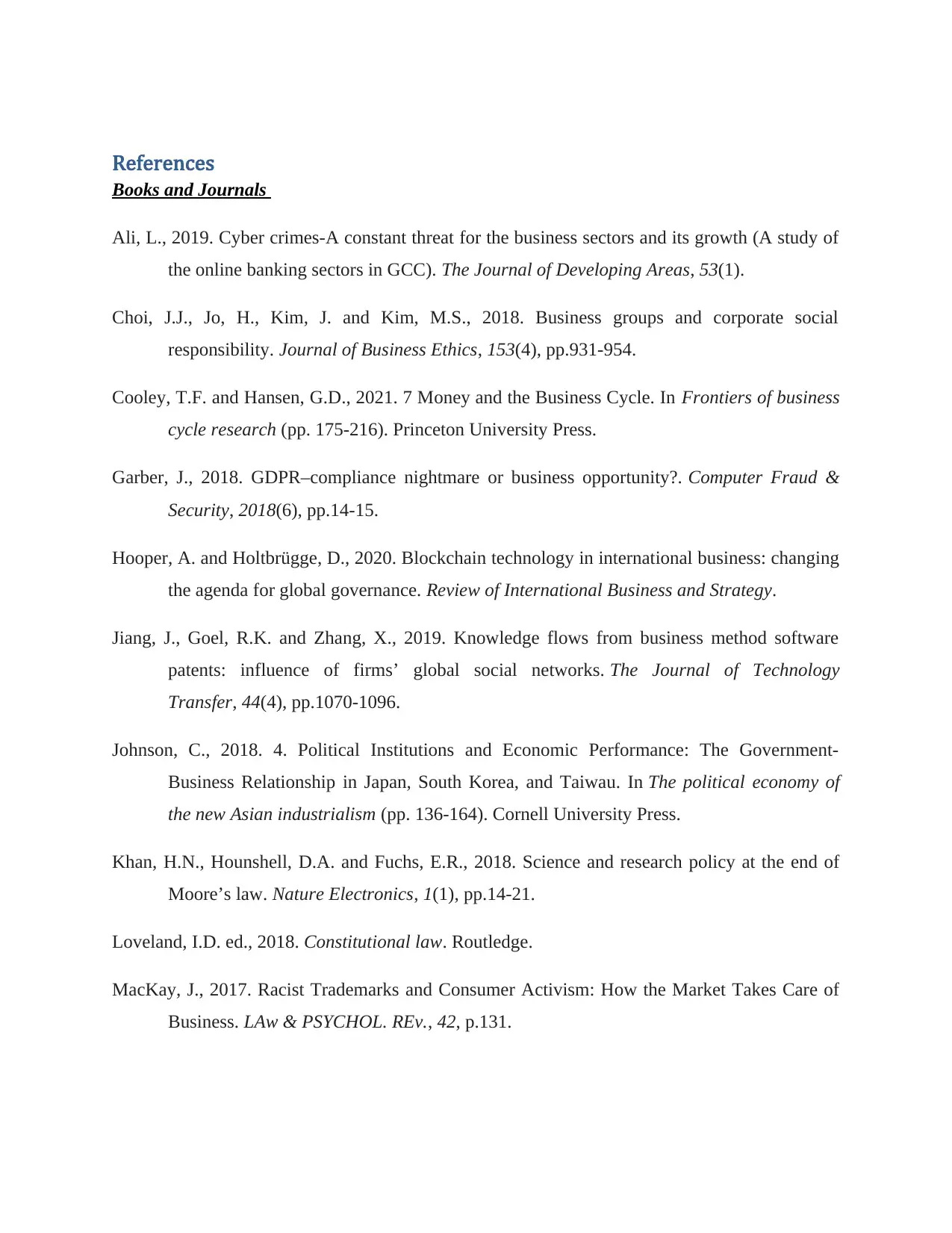
References
Books and Journals
Ali, L., 2019. Cyber crimes-A constant threat for the business sectors and its growth (A study of
the online banking sectors in GCC). The Journal of Developing Areas, 53(1).
Choi, J.J., Jo, H., Kim, J. and Kim, M.S., 2018. Business groups and corporate social
responsibility. Journal of Business Ethics, 153(4), pp.931-954.
Cooley, T.F. and Hansen, G.D., 2021. 7 Money and the Business Cycle. In Frontiers of business
cycle research (pp. 175-216). Princeton University Press.
Garber, J., 2018. GDPR–compliance nightmare or business opportunity?. Computer Fraud &
Security, 2018(6), pp.14-15.
Hooper, A. and Holtbrügge, D., 2020. Blockchain technology in international business: changing
the agenda for global governance. Review of International Business and Strategy.
Jiang, J., Goel, R.K. and Zhang, X., 2019. Knowledge flows from business method software
patents: influence of firms’ global social networks. The Journal of Technology
Transfer, 44(4), pp.1070-1096.
Johnson, C., 2018. 4. Political Institutions and Economic Performance: The Government-
Business Relationship in Japan, South Korea, and Taiwau. In The political economy of
the new Asian industrialism (pp. 136-164). Cornell University Press.
Khan, H.N., Hounshell, D.A. and Fuchs, E.R., 2018. Science and research policy at the end of
Moore’s law. Nature Electronics, 1(1), pp.14-21.
Loveland, I.D. ed., 2018. Constitutional law. Routledge.
MacKay, J., 2017. Racist Trademarks and Consumer Activism: How the Market Takes Care of
Business. LAw & PSYCHOL. REv., 42, p.131.
Books and Journals
Ali, L., 2019. Cyber crimes-A constant threat for the business sectors and its growth (A study of
the online banking sectors in GCC). The Journal of Developing Areas, 53(1).
Choi, J.J., Jo, H., Kim, J. and Kim, M.S., 2018. Business groups and corporate social
responsibility. Journal of Business Ethics, 153(4), pp.931-954.
Cooley, T.F. and Hansen, G.D., 2021. 7 Money and the Business Cycle. In Frontiers of business
cycle research (pp. 175-216). Princeton University Press.
Garber, J., 2018. GDPR–compliance nightmare or business opportunity?. Computer Fraud &
Security, 2018(6), pp.14-15.
Hooper, A. and Holtbrügge, D., 2020. Blockchain technology in international business: changing
the agenda for global governance. Review of International Business and Strategy.
Jiang, J., Goel, R.K. and Zhang, X., 2019. Knowledge flows from business method software
patents: influence of firms’ global social networks. The Journal of Technology
Transfer, 44(4), pp.1070-1096.
Johnson, C., 2018. 4. Political Institutions and Economic Performance: The Government-
Business Relationship in Japan, South Korea, and Taiwau. In The political economy of
the new Asian industrialism (pp. 136-164). Cornell University Press.
Khan, H.N., Hounshell, D.A. and Fuchs, E.R., 2018. Science and research policy at the end of
Moore’s law. Nature Electronics, 1(1), pp.14-21.
Loveland, I.D. ed., 2018. Constitutional law. Routledge.
MacKay, J., 2017. Racist Trademarks and Consumer Activism: How the Market Takes Care of
Business. LAw & PSYCHOL. REv., 42, p.131.
Paraphrase This Document
Need a fresh take? Get an instant paraphrase of this document with our AI Paraphraser
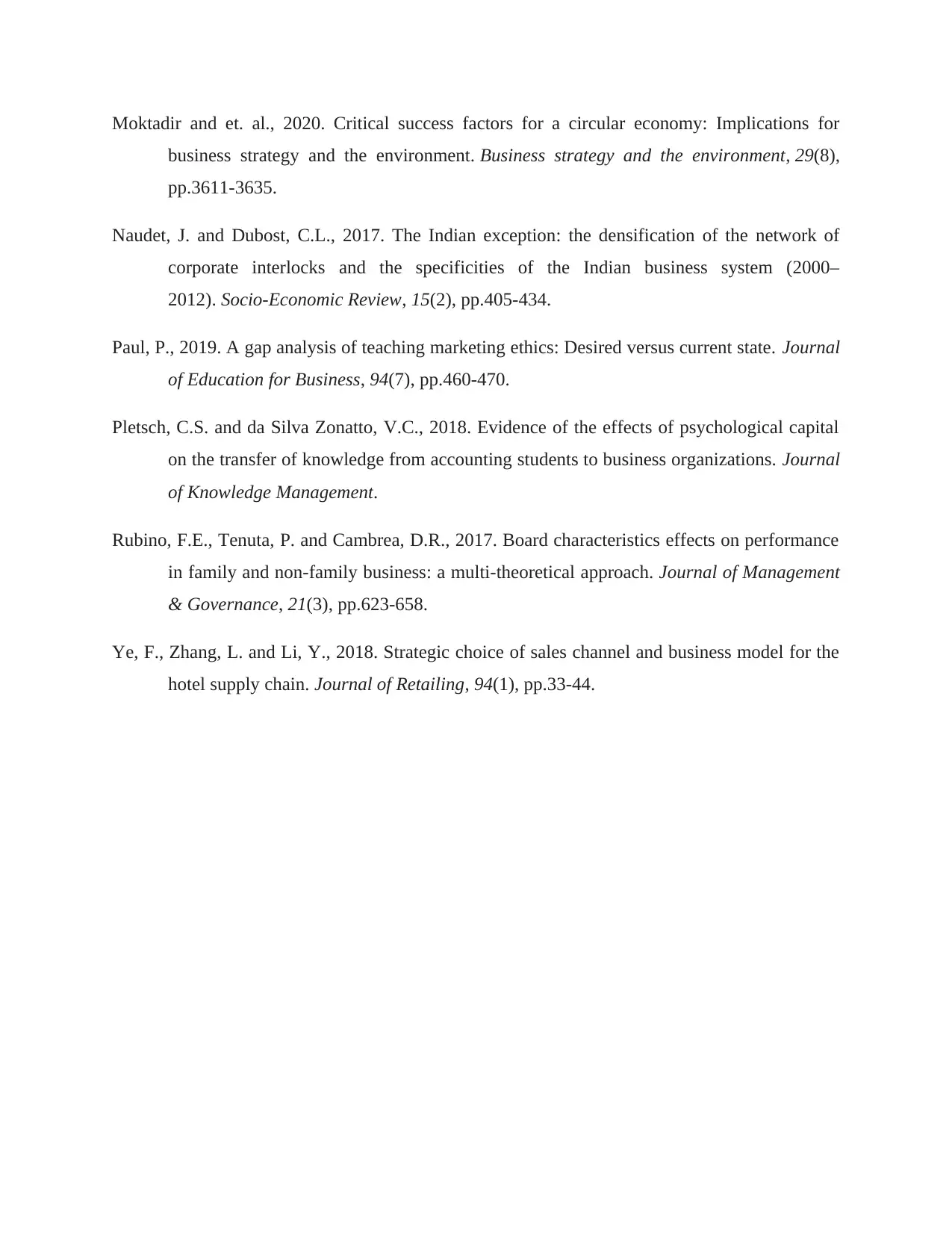
Moktadir and et. al., 2020. Critical success factors for a circular economy: Implications for
business strategy and the environment. Business strategy and the environment, 29(8),
pp.3611-3635.
Naudet, J. and Dubost, C.L., 2017. The Indian exception: the densification of the network of
corporate interlocks and the specificities of the Indian business system (2000–
2012). Socio-Economic Review, 15(2), pp.405-434.
Paul, P., 2019. A gap analysis of teaching marketing ethics: Desired versus current state. Journal
of Education for Business, 94(7), pp.460-470.
Pletsch, C.S. and da Silva Zonatto, V.C., 2018. Evidence of the effects of psychological capital
on the transfer of knowledge from accounting students to business organizations. Journal
of Knowledge Management.
Rubino, F.E., Tenuta, P. and Cambrea, D.R., 2017. Board characteristics effects on performance
in family and non-family business: a multi-theoretical approach. Journal of Management
& Governance, 21(3), pp.623-658.
Ye, F., Zhang, L. and Li, Y., 2018. Strategic choice of sales channel and business model for the
hotel supply chain. Journal of Retailing, 94(1), pp.33-44.
business strategy and the environment. Business strategy and the environment, 29(8),
pp.3611-3635.
Naudet, J. and Dubost, C.L., 2017. The Indian exception: the densification of the network of
corporate interlocks and the specificities of the Indian business system (2000–
2012). Socio-Economic Review, 15(2), pp.405-434.
Paul, P., 2019. A gap analysis of teaching marketing ethics: Desired versus current state. Journal
of Education for Business, 94(7), pp.460-470.
Pletsch, C.S. and da Silva Zonatto, V.C., 2018. Evidence of the effects of psychological capital
on the transfer of knowledge from accounting students to business organizations. Journal
of Knowledge Management.
Rubino, F.E., Tenuta, P. and Cambrea, D.R., 2017. Board characteristics effects on performance
in family and non-family business: a multi-theoretical approach. Journal of Management
& Governance, 21(3), pp.623-658.
Ye, F., Zhang, L. and Li, Y., 2018. Strategic choice of sales channel and business model for the
hotel supply chain. Journal of Retailing, 94(1), pp.33-44.
1 out of 11
Related Documents
Your All-in-One AI-Powered Toolkit for Academic Success.
+13062052269
info@desklib.com
Available 24*7 on WhatsApp / Email
![[object Object]](/_next/static/media/star-bottom.7253800d.svg)
Unlock your academic potential
Copyright © 2020–2025 A2Z Services. All Rights Reserved. Developed and managed by ZUCOL.




